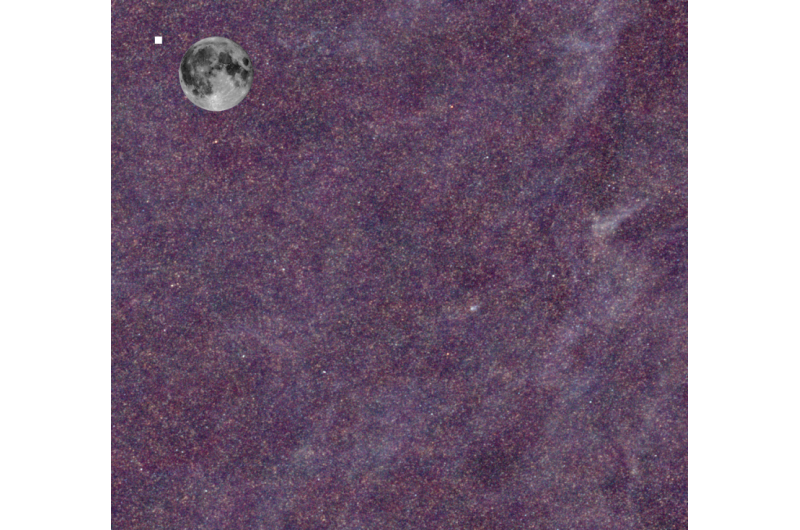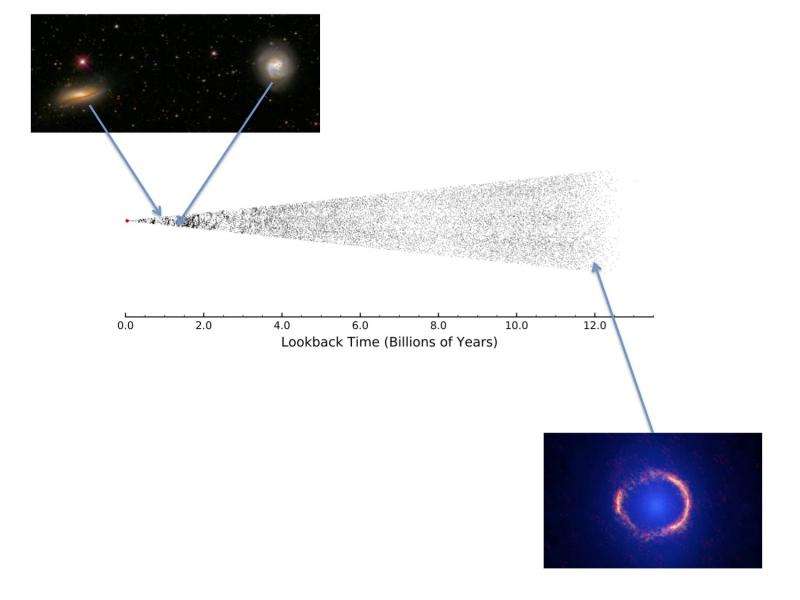A small glimpse of one region, a tenth of the full area of the Herschel ATLAS images. Everything in this image, apart from the picture of the Moon, which has just been placed there to show the area of sky covered by the survey and the small square that shows the area covered by the Hubble Deep Field, consists of far-infrared emission from cosmic dust. The faint wisps are far-infrared emission from dust grains in the Milky Way but everything else in the image is a dusty galaxy. There are approximately 6000 dusty galaxies detected in this image, while the entire survey contains roughly half a million dusty galaxies, from galaxies similar to our own, to violently star-forming and very dusty galaxies that are being seen as they were over ten billion years ago. This image also shows how the field of hidden astronomy has evolved. The Hubble Deep Field was the first area surveyed by a dust sensitive camera called SCUBA almost 20 years ago. Five galaxies were found and the observations took 50 hrs, meaning it took 10 hours observing time to detect a galaxy. The Herschel-ATLAS maps released today cover an area 100,000 times larger and it took Herschel only 5 seconds on average to detect a galaxy in these images Credit: The Herschel ATLAS team and the European Space Agency.
An international team of astronomers today (29 June) released a gazetteer of the hidden universe, which reveals the unseen sources of energy found over the last 12 billion years of cosmic history. Professor Haley Gomez of Cardiff University presented this catalogue of the Universe's hidden energy sources, made with the ESA Herschel Space Observatory, at the National Astronomy Meeting in Nottingham.
About half of the light emitted by stars and galaxies is absorbed by interstellar grains, tiny solid particles that are found everywhere in the space between the stars. The missing fifty per cent has been a huge obstacle for astronomers trying to understand the births and lives of galaxies.
When the European Space Agency (ESA) Herschel Space Observatory launched in 2009 it meant that, for the first time, it was possible to track down this hidden energy. The missing light is re-emitted by the dust grains into far-infrared radiation, detected by the Herschel telescope. For the last seven years, an international team of over 100 astronomers has been analysing the images from the largest Herschel survey, named the Herschel Astrophysical Terahertz Large Area Survey (the Herschel ATLAS). Today sees the release of their first catalogues of the hidden universe.
The Herschel ATLAS discovered about half a million far-infrared sources. The size of the survey means that the survey contains both large numbers of nearby galaxies like our own, which can be detected with conventional optical telescopes, and very distant galaxies whose light has taken billions of years to reach us. The most distant galaxies in the survey are being seen as they were 12 billion years ago, only shortly after the Big Bang. They are so dusty that they are virtually impossible to detect with standard telescopes and are often gravitationally magnified by intervening galaxies. These early systems are the distant ancestors of galaxies like our own.
Dr Elisabetta Valiante, also of Cardiff University, and the lead author of one of the papers describing the catalogues, says: "The exciting thing about our survey is that it encompasses almost all of cosmic history, from the violent star-forming systems full of dust and gas in the early universe that are essentially galaxies in the process of formation, to the much more subdued systems we see around us today."
An illustration of the time reach of the Herschel ATLAS and the kinds of objects it has discovered. The Big Bang occurred 13.7 billion years ago. The points in the diagram (approximately 40,000) show some of the Herschel ATLAS objects. The survey discovered nearby galaxies fairly similar to our own (see galaxies to the top left), and also galaxies that are so far away that we see them as they were only two billion years after the Big Bang. The figure to the bottom right shows a detailed image made with the Atacama Large Millimetre Array of one of these early galaxies. The spectacular ‘Einstein ring’ shows that the far-infrared emission from this source has been gravitationally lensed by the gravitational field of an intervening galaxy. These ultra-distant galaxies are forming stars at a rate 1000 times greater than in the Milky Way and are shrouded by dust from the view of optical telescopes. These violently star-forming and dusty galaxies are the ancestors of the galaxies around us in the Universe today. Credit: The Herschel ATLAS team, the European Space Agency, ALMA and NRAO
The huge size of the survey has meant that, for the first time, it has also been possible to study the changes that have occurred in galaxies comparatively recently in cosmic history. The team has shown that even only one billion years in the past, a small fraction of the age of the universe, galaxies were forming stars faster and contained more dust than galaxies today.
According to Dr Nathan Bourne of the University of Edinburgh, and the lead author of the other paper describing the catalogues: "We were surprised to find that we didn't need to look far in the past to see signs of galaxy evolution. Our results show that the reason for this evolution is that galaxies used to contain more dust and gas in the past, and the universe is gradually becoming cleaner as the dust is used up."
The catalogues and maps of the hidden universe are a triumph for the Herschel team. They will be vital tools for astronomers trying to explore the history of galaxies and the wider cosmos.
Dr Loretta Dunne, another Cardiff University scientist, and co-leader of the project adds: "Before Herschel we only knew of a few hundred such dusty sources in the distant universe and we could only effectively 'see' them in black and white. Herschel, with its five filters, has given us the equivalent of technicolour, and the colours of the galaxies tell us about their distances and temperatures. So now we have half a million galaxies we can use to map out the hidden star formation in the universe."
The H-ATLAS survey is a core part of the EU Research Executive Agency programme the Herschel Extragalactic Project (HELP). HELP brings together H-ATLAS and other extragalactic surveys carried out by Herschel, and combines these with major surveys by other observatories to provide a lasting legacy from the Herschel mission. This data release from the H-ATLAS team is coordinated with data releases this week from the HELP team and the Herschel Multi-tiered Extragalactic Survey (HerMES). Prof Seb Oliver of the University of Sussex leads HELP and HerMES. He says: "It is fantastic to see these high quality data products emerge from H-ATLAS, I have no doubt that astronomers will be using these for decades to come".
Göran Pilbratt, the Herschel Project Scientist adds: "Although Herschel made its last observation in 2013, current and future generations of astronomers will find the H-ATLAS maps and catalogues essential for finding their way around the hidden universe."
Provided by Royal Astronomical Society

























